Cytoarchitecture and cortical connections of the anterior insula and adjacent frontal motor fields in the rhesus monkey
- PMID: 26496798
- PMCID: PMC4662861
- DOI: 10.1016/j.brainresbull.2015.10.004
Cytoarchitecture and cortical connections of the anterior insula and adjacent frontal motor fields in the rhesus monkey
Abstract
The cytoarchitecture and cortical connections of the ventral motor region are investigated using Nissl, and NeuN staining methods and the fluorescent retrograde tract tracing technique in the rhesus monkey. On the basis of gradual laminar differentiation, it is shown that the ventral motor region stems from the ventral proisocortical area (anterior insula and dorsal Sylvian opercular region). The cytoarchitecture of the ventral motor region is shown to progress in three lines, as we have recently shown for the dorsal motor region. Namely, root (anterior insular and dorsal Sylvian opercular area ProM), belt (ventral premotor cortex) and core (precentral motor cortex) lines. This stepwise architectonic organization is supported by the overall patterns of corticocortical connections. Areas in each line are sequentially interconnected (intralineal connections) and all lines are interconnected (interlinear connections). Moreover, root areas, as well as some of the belt areas of the ventral and dorsal trend are interconnected. The ventral motor region is also connected with the ventral somatosensory areas in a topographic manner. The root and belt areas of ventral motor region are connected with paralimbic, multimodal and prefrontal (outer belt) areas. In contrast, the core area has a comparatively more restricted pattern of corticocortical connections. This architectonic and connectional organization is consistent in part, with the functional organization of the ventral motor region as reported in behavioral and neuroimaging studies which include the mediation of facial expression and emotion, communication, phonic articulation, and language in human.
Keywords: Cerebral cortex; Frontal lobe; Limbic system; Motivation; Motor behavior; Orofacial movement.
Copyright © 2015 Elsevier Inc. All rights reserved.
Figures
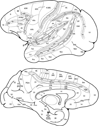




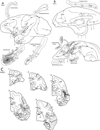
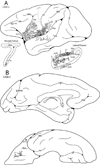




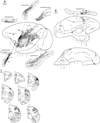
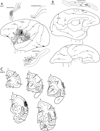

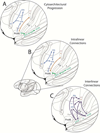

Similar articles
-
Cytoarchitecture and cortical connections of the anterior cingulate and adjacent somatomotor fields in the rhesus monkey.Brain Res Bull. 2012 Mar 10;87(4-5):457-97. doi: 10.1016/j.brainresbull.2011.12.005. Epub 2012 Jan 2. Brain Res Bull. 2012. PMID: 22240273 Free PMC article.
-
Cortical connections of the frontoparietal opercular areas in the rhesus monkey.J Comp Neurol. 1999 Jan 25;403(4):431-58. J Comp Neurol. 1999. PMID: 9888311
-
Cytoarchitecture and cortical connections of the posterior cingulate and adjacent somatosensory fields in the rhesus monkey.J Comp Neurol. 2004 Jan 26;469(1):37-69. doi: 10.1002/cne.10980. J Comp Neurol. 2004. PMID: 14689472
-
Anatomy of the auditory cortex.Rev Neurol (Paris). 1995 Aug-Sep;151(8-9):486-94. Rev Neurol (Paris). 1995. PMID: 8578069 Review.
-
The cortical connectivity of the prefrontal cortex in the monkey brain.Cortex. 2012 Jan;48(1):58-81. doi: 10.1016/j.cortex.2011.03.004. Epub 2011 Mar 15. Cortex. 2012. PMID: 21481342 Free PMC article. Review.
Cited by
-
A Protocol for Cortical Type Analysis of the Human Neocortex Applied on Histological Samples, the Atlas of Von Economo and Koskinas, and Magnetic Resonance Imaging.Front Neuroanat. 2020 Dec 7;14:576015. doi: 10.3389/fnana.2020.576015. eCollection 2020. Front Neuroanat. 2020. PMID: 33364924 Free PMC article.
-
Long-term forced-use therapy after sensorimotor cortex lesions restores contralesional hand function and promotes its preference in Macaca mulatta.Exp Brain Res. 2024 Dec 28;243(1):35. doi: 10.1007/s00221-024-06949-x. Exp Brain Res. 2024. PMID: 39731617
-
Terminal organization of the corticospinal projection from the lateral premotor cortex to the cervical enlargement (C5-T1) in rhesus monkey.J Comp Neurol. 2019 Nov 1;527(16):2761-2789. doi: 10.1002/cne.24706. Epub 2019 May 11. J Comp Neurol. 2019. PMID: 31032921 Free PMC article.
-
Behavioral flexibility is associated with changes in structure and function distributed across a frontal cortical network in macaques.PLoS Biol. 2020 May 26;18(5):e3000605. doi: 10.1371/journal.pbio.3000605. eCollection 2020 May. PLoS Biol. 2020. PMID: 32453728 Free PMC article.
-
Cytoarchitectonics of the Rolandic operculum: morphofunctional ponderings.Brain Struct Funct. 2021 May;226(4):941-950. doi: 10.1007/s00429-021-02258-z. Epub 2021 Mar 20. Brain Struct Funct. 2021. PMID: 33743075 Review.
References
-
- Andersen RA. Encoding of intention and spatial location in the posterior parietal cortex. Cereb Cortex. 1995;5:457–469. - PubMed
-
- Arce FI, Lee JC, Ross CF, Sessle BJ, Hatsopoulos NG. Directional information from neuronal ensembles in the primate orofacial sensorimotor cortex. J Neurophysiol. 2013;110:1357–1369. - PubMed
-
- Barbas H, Pandya DN. Architecture and frontal cortical connections of the premotor cortex (area 6) in the rhesus monkey. J Comp Neurol. 1987;256:211–228. - PubMed
-
- Barbas H, Pandya DN. Architecture and intrinsic connections of the prefrontal cortex in the rhesus monkey. J Comp Neurol. 1989;286:353–375. - PubMed
-
- Blatt GJ, Pandya DN, Rosene DL. Parcellation of cortical afferents to three distinct sectors in the parahippocampal gyrus of the rhesus monkey: an anatomical and neurophysiological study. J Comp Neurol. 2003;466:161–179. - PubMed
Publication types
MeSH terms
Grants and funding
LinkOut - more resources
Full Text Sources
Other Literature Sources

